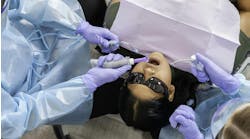Mary Govoni, CDA, RDA, RDH, MBA
For more on this topic, go to www.dentaleconomics.com and search using the following key words: infection prevention, tuberculosis exposure, reasonable accommodations, Mary Govoni.
Although the number of new cases of tuberculosis has been steadily declining in the United States for the last several years, treating patients with TB in dental facilities can pose a risk of infection to dental professionals. Both the CDC and OSHA recommend that dental practices have protocols in place for protecting employees from TB exposure. These protocols include withholding elective treatment from patients who have active TB infections.
In addition, treatment should also be withheld — at least temporarily — from patients who show possible signs of TB infection. These signs include a prolonged cough of three to four weeks or longer, coughing up blood, fever of unknown origin, fatigue or malaise, night sweats, and unexplained weight loss. These symptoms may also indicate other serious health problems for a patient. So, in any case, it would be a good idea to send a symptomatic patient for a medical consult prior to any elective treatment. Elective treatment is defined as routine, nonemergency services (prophylaxis, restorations, etc.).
The Americans with Disabilities Act prevents dentists from withholding treatment from patients with HIV/AIDS. Tuberculosis is different, however, in that the modifications that would have to be made to a dental facility to perform routine treatment on patients with active TB would be beyond the scope of “reasonable accommodations” in the act.
Initial steps in minimizing the risk of exposure to tuberculosis are to review patient medical history forms and make certain that patients are asked questions about TB, such as history and also the symptoms described previously.
Next is to perform a community risk assessment to determine the number of TB cases in the geographic area in which the practice is located. This can easily be done online through state health department websites. Most state health departments publish disease statistics by county, including TB. This information should be documented annually in the office OSHA/safety manual.
If a patient presents with possible symptoms of TB and/or a positive medical history, the dentist should refer the patient for medical screening before providing anything but emergency treatment for that patient. Keep in mind that patients may have TB, but have been in treatment for a long enough period to be classified as nonactive or noninfectious.
If a physician or health department official documents the patient’s status as such, it is safe to perform elective treatment. Some patients may have been exposed to TB and may be taking prophylactic antibiotics to prevent an infection. It is safe to treat these patients as well, but only after documentation from a physician.
A dentist is not obligated to treat new patients who indicate that they have active TB. But if a patient of record presents for emergency treatment, it is up to the dentist to determine whether to treat the patient in the office.
For minor emergencies, such as a crown that needs to be recemented or a fractured tooth that needs to be temporized, those procedures can be easily completed in the office provided that the clinical team wears the appropriate respiratory protection or face mask. This is an N-95 particulate respirator. This type of mask is approved by the National Institute for Occupational Safety and Health (NIOSH) for protection against tuberculosis and influenza. It is a good idea to have these masks on hand in case they are needed for treating a patient with TB.
Other precautions that should be taken are minimizing the creation of aerosols during treatment. Isolating with a dental dam if appropriate is one of the best methods.
If use of a dam is not appropriate, having the patient use a preprocedural mouth rinse with chlorhexidine is another effective way to reduce the microbes introduced into the air during treatment. Using high volume evacuation helps as well. Ultrasonic scalers should never be used to treat patients with active or suspected tuberculosis infections.
Remember that screening your patients for tuberculosis and symptoms of TB is an important part of the infection prevention program for your practice.
Author’s clarification: In a previous column on instrument sterilization, I was not clear on the types of indicators inside of sterilization pouches. There are some pouches that have a temperature-only indicator inside the pouch, while others have indicators that measure all three parameters for sterilization — time, temperature, and pressure. I recommend that pouches with the three-parameter indicators be used. Check with the manufacturers of the pouches you use to make sure that they are the type that meet those criteria.
Mary Govoni, CDA, RDA, RDH, MBA, is the owner of Clinical Dynamics, a consulting company based in Michigan. She is a member of the Organization for Safety, Asepsis and Prevention. She can be contacted at [email protected].





